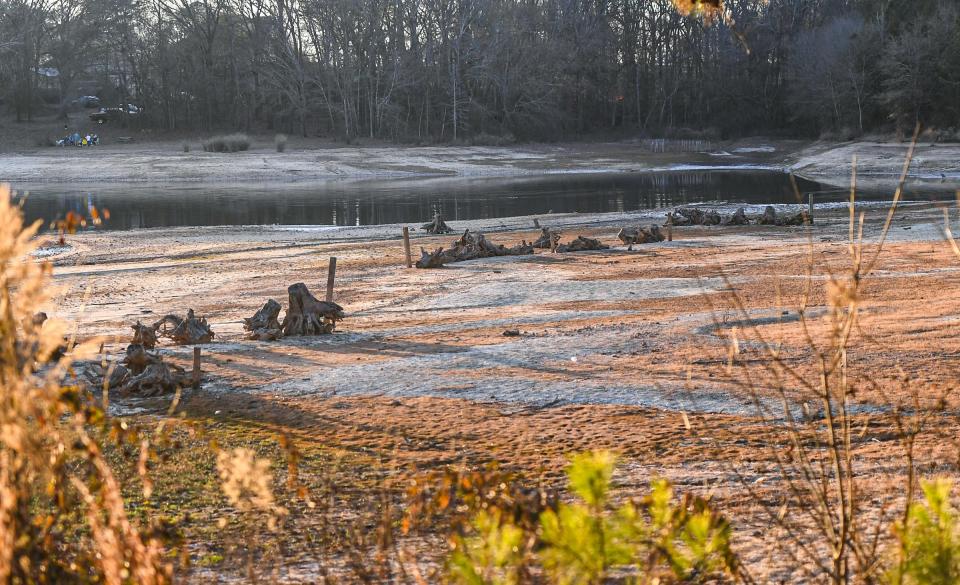Is South Carolina headed toward a drought? June brings drier conditions, less rain
After weeks of dry, hot weather, South Carolina could be headed toward a drought.
The South Carolina Drought Response Committee is scheduled to meet on July 9 after monitoring conditions across the state. During the meeting, stakeholders and experts will examine seven indicators to decide whether parts of the state are officially in a drought.
While it’s not uncommon for two or three weeks of warm weather without rain during the summer, conditions have deteriorated quickly in the last month, said State Climatologist Hope Mizzell.
“We had normal to above normal rainfall throughout the winter and into spring, which was great for replenishing our groundwater and surface water. And then, unfortunately, June hit, and it got dry in a hurry,” Mizzell said. “Not only have we had much below normal rainfall, we've had much above normal temperatures. So it's that one-two punch from the lack of rain and the heat that has resulted in a flash drought.”

A flash drought is a rapid onset of drought, usually influenced by high temperatures and low rainfall.
The committee looks at various “indicators” or impacts before officially declaring a drought. Indicators include:
Percent of normal rainfall
Crop moisture
Streamflow, lake, reservoir, and groundwater levels
Multiple drought indexes showing how long conditions have persisted and the risk of forest fires
U.S. Drought Monitor for South Carolina
“Our committee has to look at the big picture of drought and what are all the impacts across the state,” Mizzell said.
Mizzell said the Upstate saw above-average rainfall in May, but in June, the region received only half of the normal amount of precipitation. According to data from Greenville-Spartanburg International Airport dating back to 1963, the area receives an average of 4.16 inches of rain in June. This year, the station only measured 1.88 inches, making it the 13th driest June since 1963.
The Upstate isn’t just seeing less summer precipitation – something that scientists have expressed concern about in recent years. This year was also the 11th warmest June in 62 years at the Greenville-Spartanburg International Airport weather station. The station recorded a high of 99° Fahrenheit on June 26.
Mizzell said that, generally speaking, the ground needs roughly an inch of rain every week to keep up with summer evaporation. As the water from the ground is released into the atmosphere, the soil becomes drier. Because the soil is drier, farmers across the state are some of the first to see significant impacts.
According to the U.S. Department of Agriculture’s National Agricultural Statistics Service, farmers are already seeing drier soil this summer. In a weekly crop progress update published on July 1, 72% of survey respondents said the moisture levels in their topsoil were either short or very short. Consequently, some farmers also had to feed their livestock hay to supplement nutrition because grazing conditions were poor, something Mizzell said is “unheard of” this early in the year.
Read more: An Upstate drought ended in January. For farmers, the ramifications lasted for months.

“For our farmers, and the impacts to them, it has quickly progressed much further past and much beyond the first stage of drought for them. They are experiencing significant impacts,” Mizzell said.
Additionally, Mizzell said the climatology office has also heard that some water providers are seeing an increase in demand for water and lower streamflow levels than they’d expect to see this time of year.
“Since this flash drought has been quite intense, we are starting to see some hydrologic impacts, even with some of our streamflows running much below to below normal,” she said.
As of July 3, the Reedy River near Greenville saw a streamflow in the 12th percentile, considered “below normal.” A streamflow is considered “normal” between the 25th-75th percentiles.
According to some measures, like the U.S. Drought Monitor, drought has already struck the Palmetto State. As of July 3, much of South Carolina was upgraded to a moderate drought, with some parts of the state, such as Newberry, Marion, Florence, and Sumter counties, reaching severe drought status.
However, the U.S. Drought Monitor is just one indicator of many that the committee looks at before declaring a drought. It tends to look more at broad-scale conditions, while state committees can better consider local impact.
“There is a difference between dry periods and drought, and there's not a clear boundary. It really is based on the temperature and the rainfall and those impacts, and when we start to see the different indicators showing that we have now progressed from just a period of dryness into the first stages of drought,” she said. “That’s where we are now. It just happened in a very short period of time.”
The committee meets on Tuesday. Though Mizzell said she can’t forecast the decision, she believes some counties in South Carolina will be upgraded to drought status. On Tuesday, members will also decide how frequently to meet based on the severity of the impacts across the state.
Sarah Swetlik covers climate change and environmental issues in South Carolina's Upstate for The Greenville News. Reach her at[email protected] or on X at @sarahgswetlik.
Have a question for Sustainability with Sarah? Ask here or email[email protected].
This article originally appeared on Greenville News: Low rainfall in June could leave the Upstate facing flash drought
